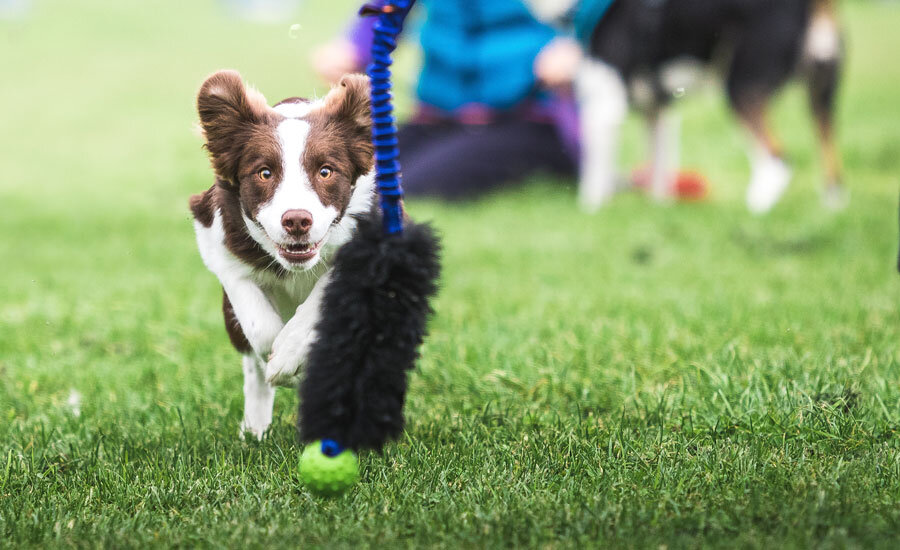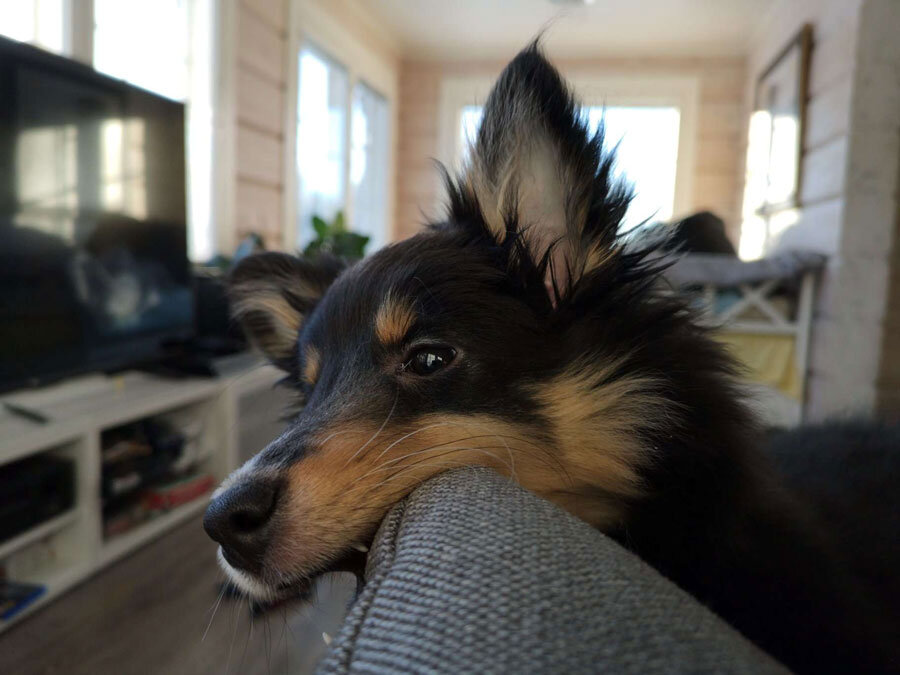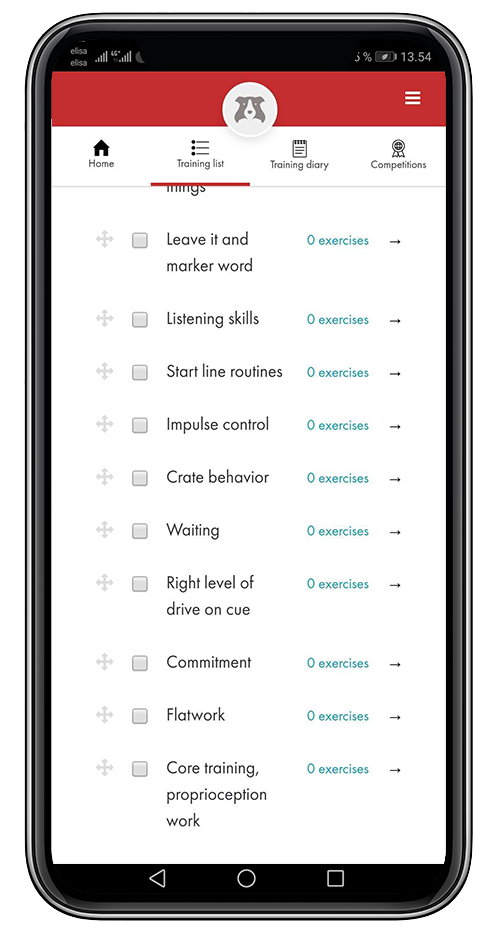The first year of a future agility dog
Prepare your puppy for an agility career you both will enjoy
Congratulations on getting a new puppy! It’s so exciting to find the puppy you want, actually get him home with you and start dreaming of doing agility with him. The first year is full of possibilities to build a solid foundation that will make your future agility career enjoyable for both you and your dog.
In this ebook, we aim to give you a clear overview of what you should keep in mind with a pup and what things affect the future career of an agility dog. At the end of the ebook, there’s a link to a training list of topics that will prepare your puppy for an enjoyable, and hopefully long, agility career.
There are many good ways to train these things. You might want to take an online course or go to puppy classes to learn more. Either way, the list is very useful since no course includes all these tasks, and by following the list, you can make sure not to forget anything important.
You can download the training list to your AgiNotes app (also to the free version) and edit it and add exercises to it (in the Premium). Also the ebook with the whole training list can be downloaded and printed as a PDF.
Relationship building first
““Only a dog that works for us, only a dog who is happy when we are happy, can give more than 100%”
”
Your number one goal for the first year with your puppy should be building a strong bond between you and your teammate. The best outcome of this work is that there is nothing better for your dog than working with you and he wants to give you absolutely everything.
Ok then, how can you build a strong relationship with your dog? Spend a lot of time with your puppy, do all kinds of fun stuff, be fair and worthy of his trust, be fun and have fun together. In the training list, almost everything is connected with this. If you do things right, your dog enjoys everything you do together.
Take time to get to know your dog
It doesn’t matter how many dogs you’ve had, they are all individuals and it takes time and effort to get to know each one.
To be able to train your dog in the best possible way, you need to know how he reacts in different situations, how motivated he is to work with you, what motivates him, what kind of activities he enjoys and so on. So, the first year is not only about training but also about making observations and taking them into account in your training and everyday life.
“If you want to get to the next level, it’s important to concentrate on the moment: on the theme at hand and the dog in front of you.
”
Build motivation
When you are asked to do something that you don’t really want to, like emptying a stinking trash can, you know how it feels. Your legs move slowly, your thoughts are elsewhere, and you’d rather leave and do something more fun.
The situation is the same with your dog. If he is doing agility in slow motion, leaving the field to do something else, it’s not fun for either of you. This is why building motivation is one of the most important parts of the first year.
To keep motivation up, keep your training sessions short, stop before the dog gets tired and shifts its attention to other things. Train just a little each time but do it often.
Play a lot with your puppy and make sure he learns to enjoy tugging, fetching and chasing, and don’t forget to build interest for a static toy. If you don’t know how to do this, join an online class on teaching motivation to get support for this.
Here are some tips: Make playing an easy and fun part of every day. If the dog doesn’t play naturally, combine food and play (e.g. use toys in which you can put food) and keep your own energy level high to get the same energy level from your dog.
Also make sure that your dog learns to love treats. This is important because with treats it is easier to teach skills that need more thinking. A toy can get the dog’s drive very high and with some dogs, way too high. If your puppy is not food motivated in the beginning, try e.g. real meat or boiled gizzard. And you can also pay attention to timing; train before you feed the puppy and when he is most probably hungry. You can also combine play with food to reinforce the meaning of treats.
In addition to playing and treats, also social rewards build motivation. Remember to praise your dog and make him see that you are very happy with him e.g. when you are training or playing with him.
Take care of your puppy’s self-esteem
Make sure not to make your puppy unsure of himself. This could compromise your relationship with him and also decrease his speed in his future agility career.
Make sure that you introduce new and difficult tasks step by step, knowing that your puppy can get through the situation a winner. E.g. don’t require your dog to perform a perfect 10-minute stay right away. As dogs are different, you need to carefully observe your dog’s actions and reactions, and learn what level of challenge he can take at once.
And don’t settle for not destroying his self-esteem; instead, make sure it is strong, so that your puppy will always feel like he’s the world champion and knows how to perform things you ask of him. Be generous with praise and leave negativity to as little as possible.
Teach your puppy to learn
“No dog is born World Champion, it’s the team that makes the titles. It’s the time, the energy and love we put into what we do together. And some dogs need more time or different motivations than others.”
If you take an adult dog that has never worked with people, it is quite hard to get him to learn what you want. However, if you start training little tricks and basic stuff from the beginning, your puppy learns how to learn.
So start doing something right from the start. In this context, it really doesn’t even matter what.
You teach your dog, as long as you do something regularly. It can be sitting, waiting for permission to get to his food bowl, tricks or anything.
Don’t rush to obstacles
a lot can be done without them
We often have big dreams for our puppies, which is ok, as long as we understand that the end result doesn’t define the value of our dog. They are precious as themselves. But what you should avoid is jumping over the foundation work and rushing into doing “real agility” with obstacles too early. And what is too early can vary from one dog to another.
The biggest reason for this is that a puppy’s body is not yet ready for the risks and the strain that performing obstacles causes. We need to protect the developing body of our dog by giving him time to grow and get stronger. This way you will hopefully get more longevity into your dog’s career.
In addition to protecting the body of your teammate, you can also prepare him a lot by doing core training and proprioception work (the ability to know where and how the body of the puppy is oriented in his surroundings) with your puppy and, hopefully, you will continue doing so throughout your dog’s career and even after it.
Another aspect your puppy needs to develop, is his mental qualities. That aspect is not necessarily ready for “real agility” with several obstacles, and the outcome can, in the worst case, be a dog that cannot control its drive.
Fortunately, there are many things you can do if you want to build strong foundations for your dog and they will keep you busy for a while!
Training list for the first year
We have created a training list that you can either download to your AgiNotes app (also to the free version) or edit it and add exercises to it (in the Premium | check the pricing). Those exercises can then be copied to your training diary with just one click. In the list, we explain how every skill in the list prepares your puppy for his agility career.
Please keep in mind that dogs are individuals right from the start: they are not born as empty canvases waiting for us to create them. However, we can impact their skills a lot. What needs more training varies from one puppy to another.
When training, add distractions gradually, keep the challenge at a level that is suitable for your puppy and remember to generalize and train the same thing in different places: first at home, then in your backyard, then in places with a bit more distraction, and also on agility fields.
Make things fun!
If you don’t yet have an AgiNotes account, you can register for free (no time limits).










